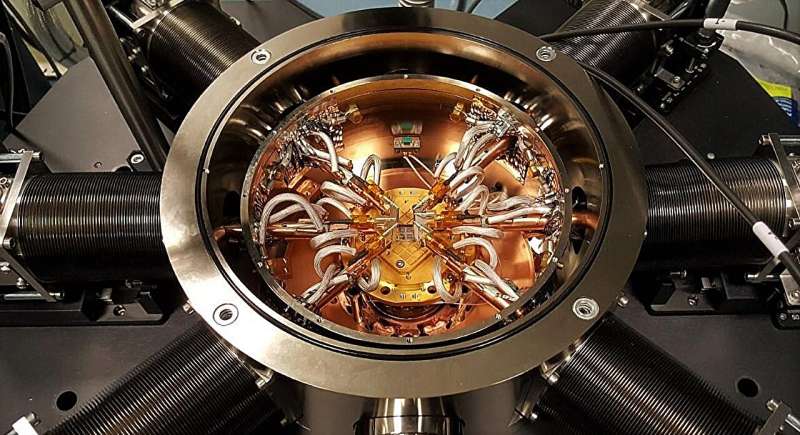This article has been reviewed according to Science X's editorial process and policies. Editors have highlighted the following attributes while ensuring the content's credibility:
fact-checked
peer-reviewed publication
trusted source
proofread
Solving the doping problem: Enhancing performance in organic semiconductors

Cavendish physicists have discovered two new ways to improve organic semiconductors. They found a way to remove more electrons from the material than previously possible and used unexpected properties in an environment known as the non-equilibrium state, boosting its performance for use in electronic devices.
"We really wanted to hit the nail and figure out what is happening when you heavily dope polymer semiconductors," said Dr. Dionisius Tjhe, Postdoctoral Research Associate at the Cavendish Laboratory. Doping is the process of removing or adding electrons into a semiconductor, increasing its ability to carry electrical current.
In a recent paper published in Nature Materials, Tjhe and his colleagues detail how these novel insights could be helpful in improving the performance of doped semiconductors.
Energy bands at unprecedented levels of doping
Electrons in solids are organized into energy bands. The highest-energy band, referred to as the valence band, controls many of the important physical properties such as electrical conductivity and chemical bonding. Doping in organic semiconductors is achieved by removing a small fraction of electrons from the valence band. Holes, the absence of electrons, can then flow and conduct electricity.
"Traditionally, only 10% to 20% percent of the electrons in an organic semiconductor's valence band are removed, which is already much higher than the parts per million levels typical in silicon semiconductors," said Tjhe. "In two of the polymers that we studied, we were able to completely empty the valence band. More surprisingly, in one of these materials we can go even further and remove electrons from the band below. This could be the first time that's been achieved!"
Interestingly, the conductivity is significantly larger in the deeper valence band, compared to the top one. "The hope is that charge transport in deep energy levels could ultimately lead to higher-power, thermoelectric devices. These convert heat into electricity," said Dr. Xinglong Ren, Postdoctoral Research Associate at the Cavendish Laboratory and co-first author of the study. "By finding materials with a higher power output, we can convert more of our waste heat into electricity and make it a more viable energy source."
Why was this observed in this material?
Although the researchers believe that the emptying of the valence band should be possible in other materials, this effect is perhaps most easily seen in polymers. "We think that the way the energy bands are arranged in our polymer, as well as the disordered nature of the polymer chains allows us to do this," said Tjhe.
"In contrast, other semiconductors, such as silicon, are probably less likely to host these effects, as it is more difficult to empty the valence band in these materials. Understanding how to reproduce this result in other materials is the crucial next step. It's an exciting time for us."
Is there another way to increase the thermoelectric performance?
Doping leads to an increase in the number of holes, but it also increases the number of ions, which limits the power. Luckily, researchers can control the number of holes, without affecting the number of ions, by using an electrode known as a field-effect gate.
"Using the field-effect gate, we found that we could adjust the hole density, and this led to very different results," explained Dr. Ian Jacobs, Royal Society University Research Fellow at the Cavendish Laboratory.
"Conductivity is normally proportional to the number of holes, increasing when the number of holes are increased, and decreasing when they are removed. This is observed when we change the number of holes by adding or removing ions. However, when using the field-effect gate, we see a different effect. Adding or removing holes always causes a conductivity increase!"
Harnessing the power of the non-equilibrium state
The researchers were able to trace these unexpected effects to a "Coulomb gap," a well-known, though rarely observed feature in disordered semiconductors. Interestingly, this effect disappears at room temperature and the expected trend is recovered.
"Coulomb gaps are notoriously hard to observe in electrical measurements, because they only become visible when the material is unable to find its most stable configuration," Jacobs added. "On the other hand, we were able to see these effects at much higher temperatures than anticipated, only about -30°C."
"It turns out that in our material, the ions freeze; this can happen at relatively high temperatures," said Ren. "If we add or remove electrons when the ions are frozen, the material is in a non-equilibrium state. The ions would prefer to rearrange and stabilize the system, but they can't because they are frozen. This allows us to see the Coulomb gap."
Usually there is a tradeoff between thermoelectric power output and conductivity—one increases while the other decreases. However, due to the Coulomb gap and the non-equilibrium effects, both can be increased together, meaning the performance can be improved. The only limitation is that the field-effect gate currently only affects the surface of the material. If the bulk of the material can be affected, it would increase the power and conductivity to even larger magnitudes.
Though the group still has some headway to make, the research paper outlines a clear method to improve the performance of organic semiconductors. With exciting prospects in the energy field, the group have left the door open for further investigation of these properties. "Transport in these non-equilibrium states has once again proved to be a promising route for better organic thermoelectric devices," said Tjhe.
More information: Dionisius H. L. Tjhe et al, Non-equilibrium transport in polymer mixed ionic–electronic conductors at ultrahigh charge densities, Nature Materials (2024). DOI: 10.1038/s41563-024-01953-6
Journal information: Nature Materials
Provided by University of Cambridge




















